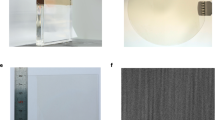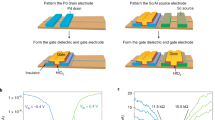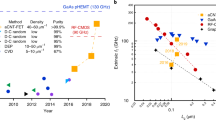Abstract
Progress in the controlled synthesis and post-growth treatment of carbon nanotubes has led to the fabrication of nanotube-based field-effect transistors with intrinsic performance close to the ballistic limits. However, nanotube-based integrated circuits (ICs) developed to date typically have a working frequency of less than 1 MHz, which is well below the working frequency of silicon ICs. Here we show that the speed of carbon nanotube ICs can be significantly improved by optimizing device structure and fabrication processes, yielding ICs that work in the gigahertz regime. Based on high-performance nanotube film field-effect transistors, five-stage ring oscillators were batch fabricated and shown to exhibit an oscillation frequency of up to 5.54 GHz. This is twenty times higher than that of the leading nanotube IC (a five-stage ring oscillator with an oscillation frequency of 282 MHz).
This is a preview of subscription content, access via your institution
Access options
Access Nature and 54 other Nature Portfolio journals
Get Nature+, our best-value online-access subscription
$29.99 / 30 days
cancel any time
Subscribe to this journal
Receive 12 digital issues and online access to articles
$119.00 per year
only $9.92 per issue
Buy this article
- Purchase on Springer Link
- Instant access to full article PDF
Prices may be subject to local taxes which are calculated during checkout



Similar content being viewed by others
References
Cavin, R. K., Lugli, P. & Zhirnov, V. V. Science and engineering beyond Moore’s law. Proc. IEEE 100, 1720–1749 (2012).
Waldrop, M. M. The chips are down for Moore’s law. Nature 530, 144–147 (2016).
Tulevski, G. S. et al. Toward high-performance digital logic technology with carbon nanotubes. ACS Nano 8, 8730–8745 (2014).
Qiu, C. G. et al. Scaling carbon nanotube complementary transistors to 5-nm gate lengths. Science 355, 271–276 (2017).
Franklin, A. D. & Chen, Z. H. Length scaling of carbon nanotube transistors. Nat. Nanotech. 5, 858–862 (2010).
Franklin, A. D. et al. Sub-10 nm carbon nanotube transistor. Nano. Lett. 12, 758–762 (2012).
Markov, I. L. Limits on fundamental limits to computation. Nature 512, 147–154 (2014).
Lee, C. S., Pop, E., Franklin, A. D., Haensch, W. & Wong, H.-S. P. A compact virtual-source model for carbon nanotube FETs in the sub-10-nm regime-part II: extrinsic elements, performance assessment, and design optimization. IEEE Trans. Electron. Devices 62, 3070–3078 (2015).
Brady, G. J. et al. Quasi-ballistic carbon nanotube array transistors with current density exceeding Si and GaAs. Sci. Adv. 2, e1601240 (2016).
Shulaker, M. M. et al. High-performance carbon nanotube field-effect transistors. In International Electron Devices Meeting (IEDM), 2014 IEEE International 33.6.1-4 (IEEE, 2014); http://doi.org/10.1109/IEDM.2014.7047164.
Cao, Y. et al. Radio frequency transistors using aligned semiconducting carbon nanotubes with current-gain cutoff frequency and maximum oscillation frequency simultaneously greater than 70 GHz. ACS Nano 10, 6782–6790 (2016).
Cao, Y. et al. High-performance radio frequency transistors based on diameter-separated semiconducting carbon nanotubes. Appl. Phys. Lett. 108, 233105 (2016).
Cao, Q. et al. Carbon nanotube transistors scaled to a 40-nanometer footprint. Science 356, 1369–1372 (2017).
Franklin, A. D. The road to carbon nanotube transistors. Nature 498, 443–444 (2013).
Yang, F. et al. Chirality-specific growth of single-walled carbon nanotubes on solid alloy catalysts. Nature 510, 522–524 (2014).
Sanchez-Valencia, J. R. et al. Controlled synthesis of single-chirality carbon nanotubes. Nature 512, 61–64 (2014).
LeMieux, M. C. et al. Self-sorted, aligned nanotube networks for thin-film transistors. Science 321, 101–104 (2008).
Lee, H. W. et al. Selective dispersion of high purity semiconducting single-walled carbon nanotubes with regioregular poly(3-alkylthiophene)s. Nat. Commun. 2, 541 (2011).
Jin, S. H. et al. Using nanoscale thermocapillary flows to create arrays of purely semiconducting single-walled carbon nanotubes. Nat. Nanotech. 8, 347–355 (2013).
Chen, Z. H. et al. An integrated logic circuit assembled on a single carbon nanotube. Science 311, 1735 (2006).
Shulaker, M. M. et al. Carbon nanotube computer. Nature 501, 526–530 (2014).
Shulaker, M. M. et al. Three-dimensional integration of nanotechnologies for computing and data storage on a single chip. Nature 547, 74–78 (2017).
Chen, H. T., Cao, Y., Zhang, J. L. & Zhou, C. W. Large-scale complementary macroelectronics using hybrid integration of carbon nanotubes and IGZO thin-film transistors. Nat. Commun. 5, 4097 (2014).
Shulaker, M. M. et al. Carbon nanotube circuit integration up to sub-20 nm channel lengths. ACS Nano 8, 3434–3443 (2014).
Geier, M. L. et al. Solution-processed carbon nanotube thin-film complementary static random access memory. Nat. Nanotech. 10, 944–948 (2015).
Chen, B. Y. et al. Highly uniform carbon nanotube field-effect transistors and medium scale integrated circuits. Nano. Lett. 16, 5120–5128 (2016).
Yang, Y. J. et al. High-performance complementary transistors and medium-scale integrated circuits based on carbon nanotube thin films. ACS Nano 11, 4124–4132 (2017).
Sun, D. M. et al. Flexible high-performance carbon nanotube integrated circuits. Nat. Nanotech. 6, 156–161 (2011).
Wang, C. et al. Wafer-scale fabrication of separated carbon nanotube thin-film transistors for display applications. Nano. Lett. 9, 4285–4291 (2009).
Kim, B. J. et al. High-speed, inkjet-printed carbon nanotube/zinc tin oxide hybrid complementary ring oscillators. Nano. Lett. 14, 3683–3687 (2014).
Zhang, P. P. et al. Transient response of carbon nanotube integrated circuits. Nano Res. 8, 1005–1011 (2015).
Han, S.-J. et al. High-speed logic integrated circuits with solution-processed self-assembled carbon nanotubes. Nat. Nanotech. 12, 861–865 (2017).
Cao, Q. et al. Medium-scale carbon nanotube thin-film integrated circuits on flexible plastic substrates. Nature 454, 495–500 (2007).
Pimparkar, N., Cao, Q., Rogers, J. A. & Alam, M. A. Theory and practice of “striping” for improved on/off ratio in carbon nanonet thin film transistors. Nano Res. 2, 167–175 (2009).
Zhou, Y. X. et al. p-channel, n-channel thin film transistors and p-n diodes based on single wall carbon nanotube networks. Nano. Lett. 4, 2031–2035 (2004).
Zhang, Z. Y. et al. Self-aligned ballistic n-type single-walled carbon nanotube field-effect transistors with adjustable threshold voltage. Nano. Lett. 8, 3696–3701 (2008).
Guerriero, E. et al. Gigahertz integrated graphene ring oscillators. ACS Nano 6, 5588–5594 (2013).
Bianchi, M. et al. Scaling of graphene integrated circuits. Nanoscale 7, 8076–8083 (2015).
Wang, H. et al. Integrated circuits based on bilayer MoS2 transistors. Nano. Lett. 12, 4674–4680 (2012).
Yang, S. et al. A high performance 180 nm generation logic technology. In International Electron Devices Meeting (IEDM), 1998 IEEE International 197–200 (IEEE, 1998); http://doi.org/10.1109/IEDM.1998.746320.
Acknowledgements
This work was supported by the National Key Research and Development Program (grant nos. 2016YF0201901 and 2016YF0201902), the National Science Foundation of China (nos. 61376126, 61621061, 61427901 and 61390504) and the Beijing Municipal Science and Technology Commission (Grant Numbers D161100002616001-3).
Author information
Authors and Affiliations
Contributions
L.-M.P. and Z.Z. proposed and supervised the project. Z.Z. and L.-M.P. designed the experiment. D.Z. and L.D. designed the CNT-based ROs. D.Z. performed experiments with the devices and fabricated and characterized the ROs. L.X. helped characterize the ROs. J.H. prepared the carbon nanotube solutions. M.X., J.S. and C.Q. deposited and annealed the CNT films. D.Z., Z.Z. and L.-M.P. analysed the data and co-wrote the manuscript. All authors discussed the results and commented on the manuscript.
Corresponding authors
Ethics declarations
Competing interests
The authors declare no competing financial interests.
Additional information
Publisher’s note: Springer Nature remains neutral with regard to jurisdictional claims in published maps and institutional affiliations.
Supplementary information
Supplementary Information
Supplementary Figures 1–12
Rights and permissions
About this article
Cite this article
Zhong, D., Zhang, Z., Ding, L. et al. Gigahertz integrated circuits based on carbon nanotube films. Nat Electron 1, 40–45 (2018). https://doi.org/10.1038/s41928-017-0003-y
Received:
Accepted:
Published:
Issue Date:
DOI: https://doi.org/10.1038/s41928-017-0003-y
This article is cited by
-
Emerging memory electronics for non-volatile radiofrequency switching technologies
Nature Reviews Electrical Engineering (2024)
-
Biotemplated precise assembly approach toward ultra-scaled high-performance electronics
Nature Protocols (2023)
-
Two-dimensional semiconductor integrated circuits operating at gigahertz frequencies
Nature Electronics (2023)
-
How to build good inverters from nanomaterial-based transistors
Nano Research (2023)
-
Carbon nanotube-based flexible high-speed circuits with sub-nanosecond stage delays
Nature Communications (2022)



